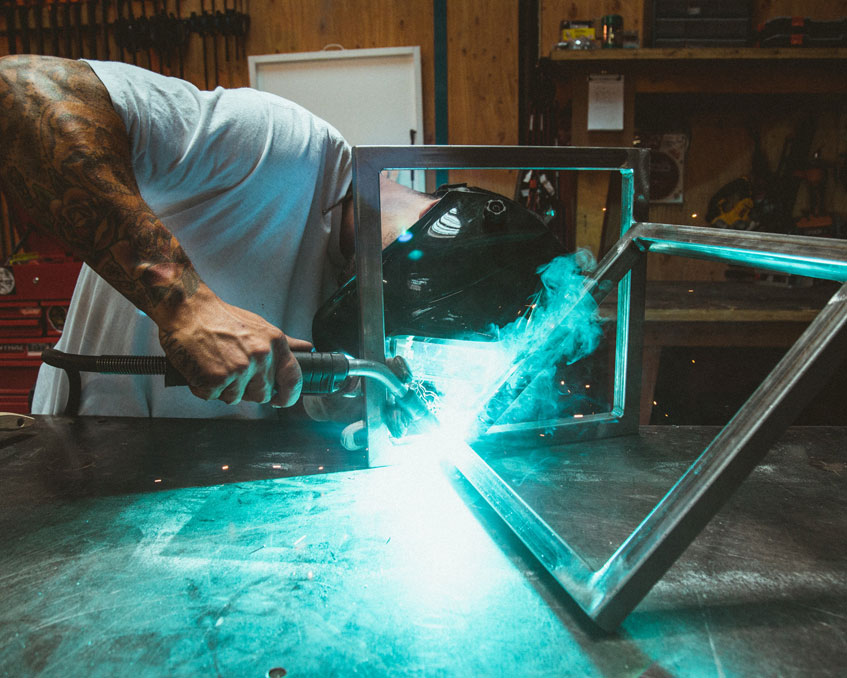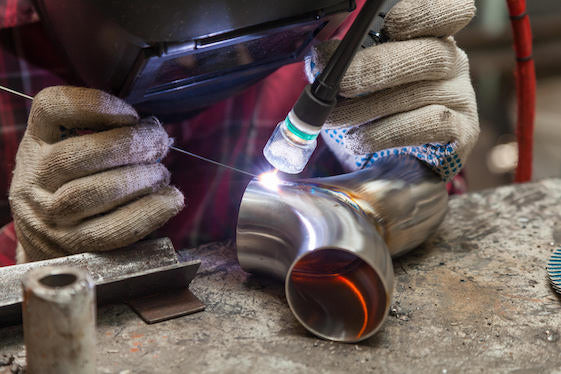Causes of weld porosity and how Belgrade Welding fixes them
Typical Welding Repair Work Issues and How to Address Them Successfully
Welding repair services usually encounter a variety of problems that can jeopardize the honesty of the last product. Common troubles include inadequate infiltration, porosity, and misalignment, amongst others. Each defect presents unique obstacles that need details methods for resolution. Comprehending these concerns is important for welders aiming to improve their abilities and end results. This discussion will certainly check out these usual welding repair concerns and reliable methods to resolve them.
Inadequate Penetration
Poor penetration happens when the weld metal falls short to fully fuse with the base product, leading to weak joints and possible structural failings. This issue commonly stems from insufficient warm input, incorrect electrode angle, or inappropriate welding rate. Welders might experience inadequate penetration because of a mistake of the necessary specifications for a certain material density or type. In addition, contamination on the base material's surface area can prevent efficient bonding, worsening the issue. To deal with poor infiltration, welders need to ensure ideal setups on their tools and keep a tidy work surface area. Normal assessment of welds is recommended to identify any type of deficiencies early, permitting for prompt modifications and the prevention of jeopardized structural stability in bonded settings up.
Porosity
Porosity is a common flaw in bonded joints that manifests as little gas bubbles caught within the weld metal. This problem can endanger the integrity of the weld, bring about lowered strength and prospective failing under stress and anxiety. Belgrade. Porosity typically develops from contamination, moisture, or improper welding techniques, which enable gases to run away right into the liquified weld pool. To resolve porosity, welders need to assure appropriate surface preparation, maintain a tidy working atmosphere, and make use of ideal welding specifications. Furthermore, picking the appropriate filler product and protecting gas can mitigate gas entrapment. Regular evaluation and screening of welds can aid determine porosity early, guaranteeing prompt restorative actions are taken, consequently protecting the high quality and reliability of the welded framework
Misalignment
Misalignment in welding can occur from various elements, including incorrect arrangement and thermal growth. Recognizing the source is important for effective resolution. Several correction techniques are offered to realign elements and guarantee architectural stability.
Reasons for Imbalance
Welding misalignment frequently originates from a selection of underlying issues that can compromise structural honesty. One primary reason is inappropriate fit-up of elements before welding, which can lead to voids and irregular surface areas. Variants in thermal growth throughout the welding process can additionally cause distortion, especially if the materials being joined have different coefficients of development. Additionally, inadequate securing and fixturing may fail to hold components safely in position, resulting in movement during welding. Poorly maintained devices, consisting of welding makers and tools, might present inconsistencies in the weld grain, further adding to misalignment. Finally, driver mistake, coming from inadequate training or experience, can additionally play a significant function in creating misaligned welds.
Adjustment Techniques Offered
Attending to imbalance efficiently calls for a combination of corrective techniques tailored to the particular problems handy. One typical method is making use of jigs or components to hold components in the correct placement throughout welding, ensuring constant placement. Additionally, pre-heating the materials can aid decrease distortion and improve fit-up. For substantial misalignment, mechanical adjustment strategies, such as using hydraulic jacks or clamps, can be utilized to correct the position before welding. Post-weld warm therapy might also be essential to ease tensions triggered by misalignment. Lastly, cautious examination and modification throughout the arrangement stage can prevent misalignment problems from becoming substantial issues, advertising a smoother welding process and boosting overall structural stability.
Distortion
Distortion is an usual challenge in welding that can develop from different aspects, consisting of unequal cooling and heating. Recognizing the sources of distortion is essential for implementing efficient avoidance strategies. Addressing this concern not only boosts structural integrity yet likewise enhances the general quality of the weld.
Root causes of Distortion
When based on the intense warm of welding, products commonly undertake adjustments that can result in distortion. This phenomenon primarily emerges from thermal growth and contraction during the welding process. As the weld location warms up, the material expands; upon air conditioning, it contracts, which can create internal tensions. In addition, uneven heating throughout a work surface can aggravate these stress and anxieties, resulting in warping or bending. The sort of product likewise plays a significant function; steels with differing thermal conductivity and coefficients of development may react in different ways, resulting in uncertain distortions. Poor joint layout and inadequate fixturing can add to imbalance during welding, enhancing the likelihood of distortion. Understanding these reasons is crucial for reliable welding repair service and prevention techniques.
Avoidance Techniques
Reliable prevention strategies for distortion during welding informative post emphasis on regulating warmth input and ensuring correct joint design. Preserving a consistent warmth input assists to reduce thermal expansion and tightening, which can lead to distortion. Making use of strategies such as pre-heating the work surface can also lower the temperature level gradient, advertising consistent home heating. Furthermore, choosing ideal joint styles, such as T-joints or lap joints, can boost stability and lower stress concentrations. Implementing appropriate fixturing to safeguard the work surfaces in location even more help informative post in maintaining alignment throughout the welding procedure. Finally, staggered welding series can disperse warm a lot more uniformly, preventing localized distortion. By using these methods, welders can greatly decrease the possibility of distortion and enhance the general high quality of their welds.
Fracturing
Splitting is an usual problem run into in welding repair services, often arising from numerous elements such as incorrect cooling prices, material option, or poor joint prep work. The event of splits can substantially compromise the honesty of the weld, resulting in prospective failures throughout procedure. To resolve this problem, welders must first analyze the source, guaranteeing that materials work and appropriately chosen for the specific application. Additionally, controlling the air conditioning price during the welding procedure is necessary; rapid air conditioning can cause stress and anxiety and bring about cracking. Appropriate joint layout and prep work also contribute to decreasing the threat. Executing these approaches can enhance weld top quality and durability, ultimately decreasing the possibility of breaking in completed weldments.

Incomplete Fusion
A substantial problem in welding repair services is insufficient combination, which takes place when the weld steel does not adequately bond with the base product or previous weld passes - Montana Mobile Welding and Repair. This problem can result in weak points in the joint, otc robot potentially jeopardizing the stability of the bonded structure. Aspects contributing to insufficient fusion include inadequate warmth input, incorrect welding technique, and contamination of the surface areas being joined. To resolve this concern effectively, welders must guarantee proper pre-weld cleaning and surface area prep work, along with change their welding specifications to achieve ample infiltration and combination. Normal assessment during the welding process can likewise assist identify insufficient fusion early, permitting timely restorative measures to enhance the total high quality of the weld
Overheating
While welding fixings can enhance structural honesty, overheating offers a considerable obstacle that can lead to material degradation. Extreme warm throughout welding can modify the mechanical properties of steels, resulting in reduced toughness, raised brittleness, and bending. This sensation is particularly critical in high-stress applications where structural reliability is vital. Recognizing getting too hot can involve aesthetic inspections for discoloration or distortion, as well as checking temperature throughout the welding procedure. To mitigate the risks related to overheating, welders ought to utilize appropriate strategies, such as managing heat input, readjusting traveling rate, and using ideal filler products. In addition, carrying out pre- and post-weld warmth therapies can aid bring back product residential properties and improve the total high quality of the fixing, making sure long-lasting efficiency and security.
Often Asked Questions
What Are the Common Indicators of a Welding Problem?

How Can I Evaluate My Welds for High quality?
To check welds for high quality, one can use aesthetic examinations, ultrasonic testing, and radiographic techniques. Each strategy guarantees structural honesty, identifies defects, and validates adherence to specified criteria, inevitably enhancing the dependability of the welded joints.
What Safety Precautions Should I Take While Welding?
When welding, one should focus on safety and security by using proper individual protective tools, making certain appropriate air flow, protecting flammable products away, keeping a clean work space, and knowing environments to stop injuries and mishaps.
Can I Repair a Weld Without Remodeling the Entire Joint?
Fixing a weld without remodeling the entire joint is possible, relying on the damage (Welding). Methods such as grinding, including filler material, or making use of a welding process can efficiently address specific defects while maintaining the bordering framework
What Equipment Are Crucial for Reliable Welding Repair Works?
Essential devices for effective welding repair services include a welding machine, wire brush, grinder, protective gear, clamps, and filler materials. Each device plays an essential duty in making certain quality and safety throughout the repair work procedure. Porosity commonly occurs from contamination, wetness, or improper welding strategies, which allow gases to leave into the molten weld pool. Improperly conserved equipment, including welding machines and devices, may present inconsistencies in the weld grain, further contributing to misalignment. When subjected to the intense warm of welding, products often go through modifications that can lead to distortion. Cracking is a common concern encountered in welding repairs, usually resulting from various variables such as inappropriate cooling prices, material option, or insufficient joint prep work. A considerable problem in welding repair work is incomplete combination, which takes place when the weld steel does not effectively bond with the base product or previous weld passes.